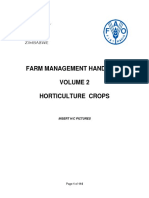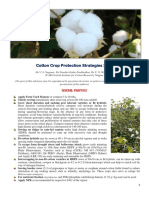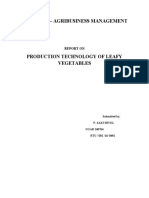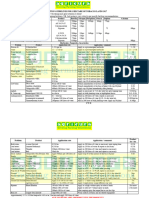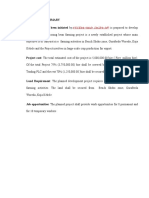0 ratings0% found this document useful (0 votes)
17 viewsPotato Complete Guide.
Potato Complete Guide.
Uploaded by
onward marumuraThe document provides a complete guide to potato production including classification, soil and climate requirements, seed requirements, spacing, varieties, fertilization, pests and diseases control, growth stages, and a sample potato program.
Copyright:
© All Rights Reserved
Available Formats
Download as PDF, TXT or read online from Scribd
Potato Complete Guide.
Potato Complete Guide.
Uploaded by
onward marumura0 ratings0% found this document useful (0 votes)
17 views6 pagesThe document provides a complete guide to potato production including classification, soil and climate requirements, seed requirements, spacing, varieties, fertilization, pests and diseases control, growth stages, and a sample potato program.
Original Title
Potato Complete Guide. (1)(1)
Copyright
© © All Rights Reserved
Available Formats
PDF, TXT or read online from Scribd
Share this document
Did you find this document useful?
Is this content inappropriate?
The document provides a complete guide to potato production including classification, soil and climate requirements, seed requirements, spacing, varieties, fertilization, pests and diseases control, growth stages, and a sample potato program.
Copyright:
© All Rights Reserved
Available Formats
Download as PDF, TXT or read online from Scribd
Download as pdf or txt
0 ratings0% found this document useful (0 votes)
17 views6 pagesPotato Complete Guide.
Potato Complete Guide.
Uploaded by
onward marumuraThe document provides a complete guide to potato production including classification, soil and climate requirements, seed requirements, spacing, varieties, fertilization, pests and diseases control, growth stages, and a sample potato program.
Copyright:
© All Rights Reserved
Available Formats
Download as PDF, TXT or read online from Scribd
Download as pdf or txt
You are on page 1of 6
POTATO PRODUCTION
A complete Guide
By Dahlia Shumba 0717816552
Promoting Farming Excellence
Potato Production
Classification Family Solanaceae
Genus Solanum
Species Tuberosum
Soil requirements Soils Medium textured to heavy clay loams
5.0-5.5, Potato require slightly acidic soils. It is
recommended not to apply lime to potato crop to reduce
incidences of Potato Scab Disease. Lime can be applied
pH a season before planting potatoes
Climatic requirements Temperature 18-22ᵒC (not below 12ᵒC, not above 36ᵒC
Time of planting Summer crop November
Winter irrigated crop February- April
Spring irrigated crop Late July – Early August
Seed requirement Seeds/ha 30kg pockets 75-85 pockets
* 25kg pockets 85-95 pockets
Spacing Interrow 90-120cm, 90cm is mostly recommended
Inrow 25-30cm, 30cm is mostly recommended
Plant population Minimum 27k
Maximum 44k
Medium early (90-
110days) Diamond, Lanorma, BP1, Innovator
Medium late (110-
120days) Jasper, Mnandi, Avalanche, Mondial, Fabula
Varieties Late (130-140days) Sifra, Panamera, Amethyst
Make sure to plant sprouted tubers to ensure uniform
and early emergence. Breaking dormancy is therefore
required and this ca be done by
Heat treatment
Sprouting Gibberellic acid application at 16ml/100l water
Fertilisation
Application Fertiliser Composition Rate/plant Remarks
Basal Compound C 5 : 15 : 12 60g All at planting
Mono Ammonium
Top dressing Phosphate 12 : 61 : 0 5g Once off application
Ammonium Nitrate 34.5 : 0 : 0 5g Once off application
Potassium nitrate 13 : 0 : 46 16g Split application
Mono ammonium phosphate
Apply 5g (Cup 5) at week 2 after emergence
Ammonium nitrate
Apply 5g (Cup 5) at week 4 after emergence
Potassium nitrate
Split apply equally (Cup 8) at week 6 and 8 after emergence
Supplementary fertilisers
Winstart- spray at week 2 and 3 at 1% solution (10g/l of water)
Promoting Farming Excellence
Wingrow- spray at week 4 and 5 at 1% solution (10g/l of water)
Winbloom- spray from week 6 onwards at 1% solution (10g/l of water)
Calcium nitrate- spray from week 7 onwards at 2g/l of water every 2 weeks
NB: More supplementary fertilisers are available on the market
Total fertiliser application = Rate/plant * Plant population (Divide by 1000 to convert to kgs)
Ridging
Ridging can be done soon after every top dressing to increase fertiliser use efficiency
*There is direct correlation between fertilisation and yield, thus the more you fertilise, the more the yield obtained
*Pay attention to the amount of organic fertiliser to avoid later mineralisation
PESTS, DISEASES, WEEDS CONTROL
Herbicides
Pre-emergence Metolachlor
Post-emergence Propaquizafop, Fluazifop-p-Butyl
Pests
Nematodes Stink bug Aphids
Oxamyl, Fenamiphos, Velum Methomyl, Imidacloprid, Imidacloprid, Acetamiprid,
Acetamiprid, Malathion, Dichlorvos Malathion, Dichlorvos, Dimethoate
Deltamethrin
Whitefly American leafminer Redspider
Thiamethoxam, Methomyl, Acetamiprid, Abamectin, Amitraz, Dicofol, Abamectin,
Imidacloprid, Acetamiprid, Cyromazine, Novaluron, indoxacarb, Diazinon, Profenofos, Chlofernapyr,
Dichlorvos, Chess Deltamethrin, Emamectin benzoate Emamectin benzoate, Dimethoate
Tuta Potato tuber moth Semi-looper
Promoting Farming Excellence
B. thrungiensis, Acephate, Cartap hydrochloride, Deltamethrin, Emamectin benzoate, Lufenuron, Indoxacarb,
Fipronil, Flubendiamide, Chlorantraniliprole, Mercaptothion, Abamectin, Malathion, Dichlorvos, Methomyl,
Diazinon, Chlorpyrifos
Wireworm Thrips Cutworms
Chlorpyrifos, Deltamethrin Abamectin, Imidacloprid, Chlorpyrifos, Lambda cyhalothrin,
Acetamiprid, Malathion, Dichlorvos, Carbaryl, Deltamethrin
Deltamethrin
Fire ants Whitegrubs Termites
Chlopyrifos, Imidacloprid, Fipronil Chlorpyrifos, Lambda cyhalothrin, Chlopyrifos, Imidacloprid, Fipronil
Deltamethrin
Diseases
Damping off Downey/Powdery mildew Late blight
Captan, Copper oxychloride, Mancozeb, Copper oxychloride, Mancozeb, Copper oxychloride,
Mancozeb, Thiram, Metalaxyl Chemlaxyl, Chlorothalonil, Propineb Chlorothalonil, Propineb,
Chemlaxyl, Cymoxanil
Promoting Farming Excellence
Early blight Potato Scab Bacterial complex
Fungicides are not effective in
controlling bacterial diseases
Always plant certified seed
resistant to diseases
Application of Acibenzolar-S-
Methyl will activate the plant
against bacterial diseases
Mancozeb, Copper oxychloride, Take care of good soil moisture and
Tebuconazole, Chlorothalonil, avoid liming the potato crop
Difenoconazole, Trifloxystrobin,
Azoxystrobin
**Always read the labels on chemicals for rates and post-harvest intervals
**Chemicals listed in active ingredients, trade names may differ
**Chemical colour codes do not illustrate the effectiveness in pest control, but the toxicity to the operator
Haulm killing
Killing the foliage of potato plants(haulm) facilitate tuber detachment and skin hardening which increase strength
and storability. This can be done by
Applying non-selective herbicides
Slashing off the foliage
Waiting for the foliage to naturally dry off
Harvesting will be ready in 10-14days after haulm killing
Growth stages
Promoting Farming Excellence
Potato Program
Planting date Variety
Plant pop Area Spacing
Monday Tuesday Wednesday Thursday Friday
Week after Age Date Herbicides/ 16l Fertilisers/plant Pesticides/ 16l Fungicides/ 16l Foliar sprays/
emergence knapsack knapsack 16l knapsack
Planting Metolachlor Compound C 60g Oxamyl 160ml
120ml
0 0 Lambda 16ml Copper 80g
1 7 Dichlorvos 16ml Bravo 32ml
2 14 MAP 5g Abamectin 16ml Antracol 32g Winstart 160g
3 21 Carbaryl 24g Acomil 50g Winstart 160g
4 28 Fluazifop 120ml AN(NH₄NO₃) 5g FD Muroti 16ml Orius 16ml Wingrow 160g
5 35 Belt 4ml Copper 80g Wingrow 160g
6 42 PN(KNO₃) 8g Dichlorvos 16ml Bravo 32ml CN 160g
7 49 Abamectin 16ml Antracol 32g Winbloom 160g
8 56 PN(KNO₃) 8g Carbaryl 24g Acomil 50g CN 160g
9 63 FD Muroti 16ml Orius 16ml Winbloom 160g
10 70 Belt 4ml Copper 80g CN 160g
11 77 Dichlorvos 16ml Bravo 32ml Winbloom 160g
12 84 Abamectin 16ml Antracol 32g CN 160g
13 91 Carbaryl 24g Acomil 50g
14 98 FD Muroti 16ml Orius 16ml
15 105 Belt 4ml
16 112
17 119
Promoting Farming Excellence
You might also like
- Sustainable Tomato Production For ZimbabweDocument43 pagesSustainable Tomato Production For Zimbabweonward marumura100% (2)
- 50 Sow Unit Piggery Business Plan Financials - USDDocument15 pages50 Sow Unit Piggery Business Plan Financials - USDonward marumuraNo ratings yet
- Butternut Complete Guide.Document4 pagesButternut Complete Guide.Stephen Swella100% (1)
- Farm Management Handbook v2 Horticulture-1Document114 pagesFarm Management Handbook v2 Horticulture-1Musariri TalentNo ratings yet
- Potato Simplified GuideDocument8 pagesPotato Simplified Guidedahlia nyangaNo ratings yet
- Tomato Complete Guide.Document7 pagesTomato Complete Guide.Benjamin TondondoNo ratings yet
- Tomato Complete Guide.-1Document8 pagesTomato Complete Guide.-1apostlecmutandidzigwaNo ratings yet
- Tomato Simplified GuideDocument6 pagesTomato Simplified Guidedahlia nyangaNo ratings yet
- Pepper Brief GuideDocument2 pagesPepper Brief GuideTatenda LwandaNo ratings yet
- Baby Marrow Complete Guide (1) - 012346Document7 pagesBaby Marrow Complete Guide (1) - 012346joeshoniwa2No ratings yet
- Carrot Complete GuideDocument5 pagesCarrot Complete GuideBenjamin TondondoNo ratings yet
- Wheat Complete Guide. - 012334Document4 pagesWheat Complete Guide. - 012334joeshoniwa2100% (1)
- Cabbage Simplified Guide by DahliaDocument6 pagesCabbage Simplified Guide by Dahliadahlia nyangaNo ratings yet
- Carrot Simplified GuideDocument5 pagesCarrot Simplified Guidedahlia nyangaNo ratings yet
- Watermelon Simplified GuideDocument7 pagesWatermelon Simplified GuideMafararikwa ReyaiNo ratings yet
- Watermelon Complete Guide.Document4 pagesWatermelon Complete Guide.Raymond M KamundimuNo ratings yet
- IPM Schedule For Chilli Cultivation: Ralstonia, Alternaria EtcDocument4 pagesIPM Schedule For Chilli Cultivation: Ralstonia, Alternaria EtcHonnur BashaNo ratings yet
- Crop Advisory - CornDocument6 pagesCrop Advisory - CornTirumalesh ReddyNo ratings yet
- 04 Soya BeanDocument7 pages04 Soya BeanNk MeenaNo ratings yet
- Sugar Bean Production Manual - 0Document33 pagesSugar Bean Production Manual - 0CORNANDONo ratings yet
- Pest Identification Guide - 011919Document5 pagesPest Identification Guide - 011919joeshoniwa2No ratings yet
- Maize Simplified GuideDocument4 pagesMaize Simplified Guidedahlia nyangaNo ratings yet
- Crop Recommendation YamDocument4 pagesCrop Recommendation YamReginald GittensNo ratings yet
- Agricura 1ha Potatoes 2017 2Document2 pagesAgricura 1ha Potatoes 2017 2nthabeleng makwaibaNo ratings yet
- Seed Treatment For Quality EnhancementDocument27 pagesSeed Treatment For Quality EnhancementjmghNo ratings yet
- Butternut Production GuideDocument5 pagesButternut Production Guidedaddy.wafaNo ratings yet
- Sugar Bean Production ManualDocument33 pagesSugar Bean Production ManualearnesteamohNo ratings yet
- Agricura 1ha Butternuts 2017 1Document1 pageAgricura 1ha Butternuts 2017 1Kenneth NyotaNo ratings yet
- Agricura 1ha Wheat 2017Document1 pageAgricura 1ha Wheat 2017Tatenda LwandaNo ratings yet
- Cotton IpmDocument7 pagesCotton IpmVinod NayakNo ratings yet
- Non Insect PestsDocument25 pagesNon Insect PestsAshwini AshwiniNo ratings yet
- 126-Pests of SugarcaneDocument5 pages126-Pests of SugarcaneMoazzam AliNo ratings yet
- Agricura 1ha Soyabean 2017Document2 pagesAgricura 1ha Soyabean 2017kudachasakaraNo ratings yet
- Cucumber: Crop GuideDocument4 pagesCucumber: Crop GuideDidi CarsidiNo ratings yet
- Microbial Control For Plant Disease in Thailand: Watchalee SopinDocument80 pagesMicrobial Control For Plant Disease in Thailand: Watchalee SopinImie S. Canaria100% (1)
- Fungicide Resistance PDFDocument36 pagesFungicide Resistance PDFVatsal SinghNo ratings yet
- Eggplant: VarietiesDocument4 pagesEggplant: VarietiesMariana LuaboNo ratings yet
- Matag Coconut 1. Matag CoconutDocument4 pagesMatag Coconut 1. Matag CoconutNek YakkNo ratings yet
- ButternutDocument6 pagesButternutmendymphonyana02No ratings yet
- Glufosinatoccab 200 SLDocument22 pagesGlufosinatoccab 200 SLJefferson MeloNo ratings yet
- GramDocument21 pagesGramdasjay185No ratings yet
- Mini Catalog - Bio MarinusDocument2 pagesMini Catalog - Bio Marinusapi-270444351100% (1)
- Always Read Labels Before Using The ProductsDocument1 pageAlways Read Labels Before Using The ProductsShadreck MabvoroNo ratings yet
- Equator CatalogueDocument25 pagesEquator CatalogueNorman Adimo100% (1)
- 1 HA Sugar Beans APRIL 2017-4Document1 page1 HA Sugar Beans APRIL 2017-4MichaelNo ratings yet
- UntitledfjgdfcvDocument6 pagesUntitledfjgdfcvMichaelNo ratings yet
- Classification of FungicidesDocument86 pagesClassification of FungicidesSpot SpotNo ratings yet
- CucumberDocument6 pagesCucumberMd Sahin SirajNo ratings yet
- Syngenta AhmedDocument5 pagesSyngenta Ahmedmrusamachohan786No ratings yet
- Chemicals JogiDocument12 pagesChemicals JoginormanwillowNo ratings yet
- Department of Plantation Management Handout On Plantation Crop Production I (PM 3129)Document8 pagesDepartment of Plantation Management Handout On Plantation Crop Production I (PM 3129)K S KumaraNo ratings yet
- Abm - Hot - Agribusiness Management: Report OnDocument6 pagesAbm - Hot - Agribusiness Management: Report Onyazhini thangaveluNo ratings yet
- Gerbera InvDocument4 pagesGerbera InvAbhishek SinghNo ratings yet
- WatermelonsDocument9 pagesWatermelonsRaymond M KamundimuNo ratings yet
- Agricura 1ha Tomatoe 2017 1Document2 pagesAgricura 1ha Tomatoe 2017 1downtopNo ratings yet
- Sugar BeansDocument5 pagesSugar BeansCarlisle MNo ratings yet
- Agricura 1ha Tobacco Lands 2017Document2 pagesAgricura 1ha Tobacco Lands 2017Mafararikwa ReyaiNo ratings yet
- Lec1 WordDocument10 pagesLec1 WordViji ThulasiramanNo ratings yet
- Integrated Disease Management in Vegetable CropsDocument56 pagesIntegrated Disease Management in Vegetable CropsSavita Bhoutekar100% (1)
- Field Tomato Production Guide 2016 PDFDocument6 pagesField Tomato Production Guide 2016 PDFJonathan de JongNo ratings yet
- Production Requirements For 1 Hectare of MaizeDocument2 pagesProduction Requirements For 1 Hectare of MaizeShadreck MabvoroNo ratings yet
- Organic Production of Some Agronomic Crops: Basmati Rice, Cotton, Red Gram and SugarcaneFrom EverandOrganic Production of Some Agronomic Crops: Basmati Rice, Cotton, Red Gram and SugarcaneNo ratings yet
- Business Weekly 030524...Document16 pagesBusiness Weekly 030524...onward marumuraNo ratings yet
- Afrostain Apple Production GuideDocument9 pagesAfrostain Apple Production Guideonward marumuraNo ratings yet
- Commercial Pig Production Guide 2023Document63 pagesCommercial Pig Production Guide 2023onward marumura100% (1)
- Environmental Impacts of Industrial Activities On The Suez Bay (Problem and Solution)Document21 pagesEnvironmental Impacts of Industrial Activities On The Suez Bay (Problem and Solution)Dina FitrianiNo ratings yet
- 리딩마스터 실전독해_학생용-잠금 해제됨Document152 pages리딩마스터 실전독해_학생용-잠금 해제됨8955388No ratings yet
- Halaman IsiDocument13 pagesHalaman IsiKeyla AishaNo ratings yet
- BK Medicinal PlantsDocument307 pagesBK Medicinal PlantsАкиф РзайевNo ratings yet
- TLE 7 - 1st Q Crop ProductionDocument4 pagesTLE 7 - 1st Q Crop ProductionGirlie AbejoNo ratings yet
- Water Quality Monitoring 2Document35 pagesWater Quality Monitoring 2ROLAND JOIE GELI100% (1)
- WK WK: Follow This Schedule When UsingDocument2 pagesWK WK: Follow This Schedule When UsingRafael S. de BemNo ratings yet
- State Trading CorporationDocument110 pagesState Trading CorporationIshrat Motiwala100% (2)
- Snail FarmDocument14 pagesSnail Farmkantamnenisrinivas1No ratings yet
- Effect of Application Rate of Urea On The Growth, Bulb Yield and Quality of OnionDocument10 pagesEffect of Application Rate of Urea On The Growth, Bulb Yield and Quality of OnionRadwan AjoNo ratings yet
- Hot Pepper: Land PreparationDocument4 pagesHot Pepper: Land PreparationAmber ThompsonNo ratings yet
- Caie Igcse Chemistry 0620 Theory 642316290154dd6525d4e88a 814Document5 pagesCaie Igcse Chemistry 0620 Theory 642316290154dd6525d4e88a 814Taha KamilNo ratings yet
- Gliricidia Sepium FactsheetDocument4 pagesGliricidia Sepium FactsheetJapachumi JaguaNo ratings yet
- Impact of Organic Manures and Biofertilizers On Growth and Yield of Onion (Allium Cepa L.)Document4 pagesImpact of Organic Manures and Biofertilizers On Growth and Yield of Onion (Allium Cepa L.)RishamNo ratings yet
- Metalliferous Industrial Minerals 2014 Part 3Document30 pagesMetalliferous Industrial Minerals 2014 Part 3DeeNo ratings yet
- unit 1Document29 pagesunit 1chamundeeswariNo ratings yet
- NSTP FinalsDocument7 pagesNSTP FinalsRosemenjelNo ratings yet
- Explain The Main Contribution, Potentials, Characteristics, and Problems of Ethiopian AgricultureDocument3 pagesExplain The Main Contribution, Potentials, Characteristics, and Problems of Ethiopian Agriculturepomi 1d96% (23)
- Dr. Norashikin Binti Ahmad Kamal Madam Azianabiha Binti A. Halip at KhalidDocument29 pagesDr. Norashikin Binti Ahmad Kamal Madam Azianabiha Binti A. Halip at KhalidShamir RoslanNo ratings yet
- DR - EdosaDocument29 pagesDR - EdosaJemal100% (1)
- Chapter - 15 Improvement - in - Food - ResourcesDocument23 pagesChapter - 15 Improvement - in - Food - Resourcesrajiv.sharma0906No ratings yet
- PomegranatesDocument5 pagesPomegranatesbig johnNo ratings yet
- The Effect of GallusDocument7 pagesThe Effect of GallusDan Jenniel CedeñoNo ratings yet
- 3.2 Nano Seed PrimingDocument20 pages3.2 Nano Seed Primingraj groupNo ratings yet
- The Nutrient Content of Paspalum Atratum Grass Associated With Macroptilium Lathyroides Legume Inoculated With Rhizobium Through The Application of Molybdenum and Phosphorus FertilizersDocument5 pagesThe Nutrient Content of Paspalum Atratum Grass Associated With Macroptilium Lathyroides Legume Inoculated With Rhizobium Through The Application of Molybdenum and Phosphorus FertilizersMamta AgarwalNo ratings yet
- McGrath y Penn 2014 PDFDocument21 pagesMcGrath y Penn 2014 PDFZayra Samara BastidasNo ratings yet
- 3733 ABC of Mineral FertilizersDocument16 pages3733 ABC of Mineral FertilizersmNo ratings yet
- Use Rabbit Urine To Repel Pests - Daily MonitorDocument13 pagesUse Rabbit Urine To Repel Pests - Daily Monitoraquamariaxtine5914No ratings yet
- VishwatejDocument11 pagesVishwatejVishwatej NalawadeNo ratings yet
- Practical Research 1Document65 pagesPractical Research 1Zeke YurixoNo ratings yet



